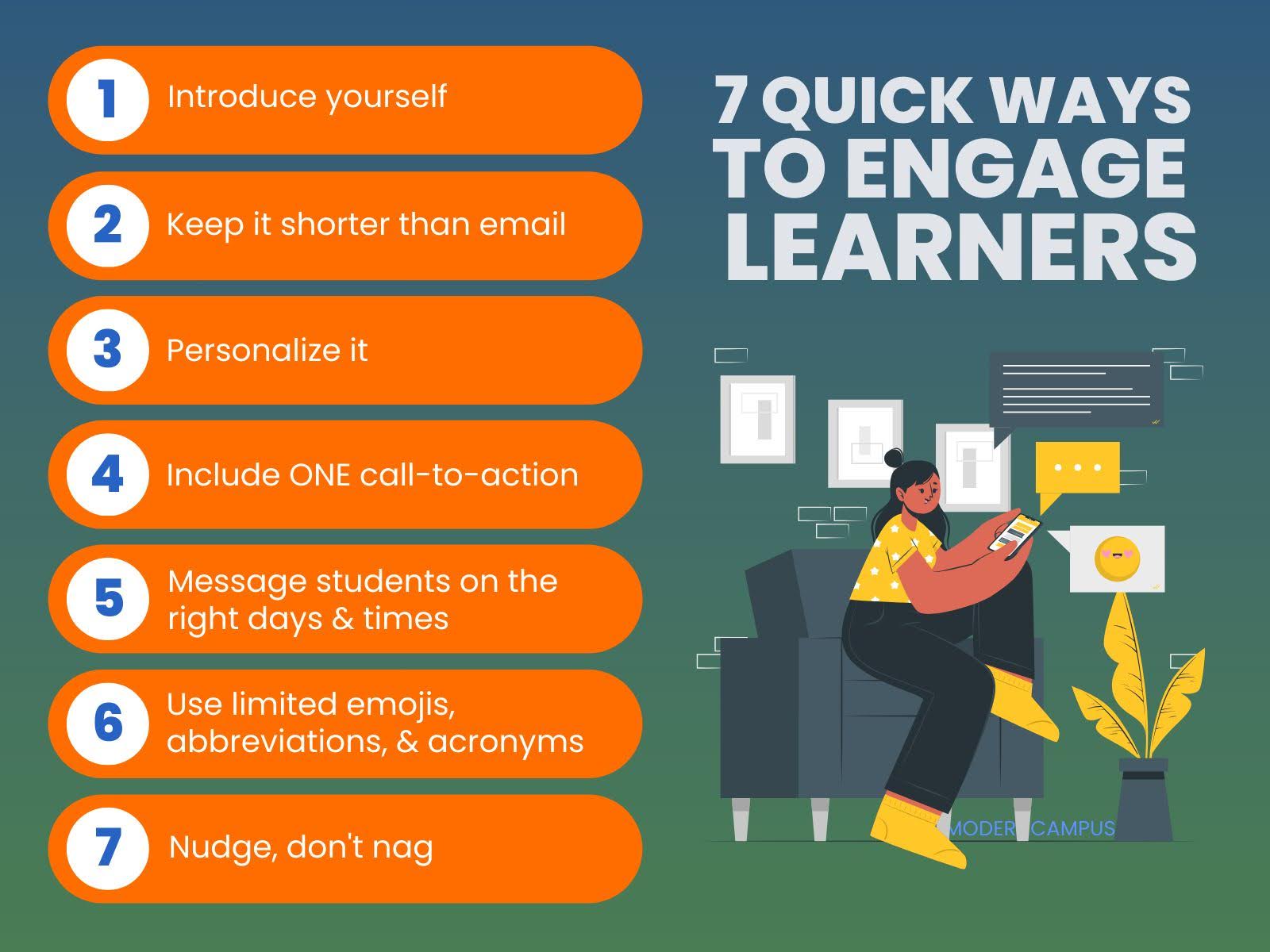How to Win Students: 7 Keys to Engaging Students with Texts
Email has become background noise for today's students, with open rates hovering around 20 percent. Text messages, on the other hand, command an astounding 98 percent read rate according to Gartner research. This stark difference reflects a fundamental shift in how today's students prefer to communicate and receive information.
But getting students to open a message is just the first step—especially among today's digitally savvy learners. They won't hesitate to leave poorly constructed messages on read or opt out entirely. One misstep in your texting strategy could sever a crucial communication channel and undermine the engaging relationships you're working to build. But there are ways to make sure that doesn't happen.
Building Better Connections: Engaging Students With Text Messaging
Through extensive research and real-world testing, we've identified proven strategies that not only capture students' attention but keep them actively engaged. Here are seven winning approaches that will transform your institution's text communication strategy.

1. Start by introducing yourself
Today’s learners, especially Generation Z, are skeptical of outbound communication. They’re quick to think texts are unsolicited spam. A message that says “Apply to our college today!” or “We’re waiting for your FAFSA,” without revealing who is making these requests will likely cause most students to ignore or delete the text.
Introducing yourself showcases transparency. It’s important to highlight which department or office is behind the message. Better yet, if you share your name (rather than just your job title), you’ll add some personality. Students may even find you on your college or university’s website, which lends credibility.
Be sure to include the following elements in your introductory text:
- Who You Are: Say your name, office and institution.
- Why You’re Texting: Let students or prospects know that you’ll be sending relevant, timely messages to help them meet a certain challenge or navigate a certain aspect of student life.
- How To Opt Out: The FCC requires you to tell students how they can opt out of receiving your messages.
Examples:
- ❌ Losing message: Discover financial aid info for Signal Vine College at [link].
- ✅ Winning message: Hi Daniela, this is Kim, your advisor at SVC. 👋 I’ll be texting financial aid info to you this semester. Don’t want texts? Text back “stop.”
2. Keep it shorter than email
It may be tempting to copy-paste your entire email into a text and hit “send” as-is. After all, all four paragraphs are super important! But think of the last time you received a multi-paragraph text message without groaning. Students don’t want that either.
Text messages should be ideally no more than 300 characters. You can use links to encourage students to assess additional information directly through the text thread. PDFs and image files can also supply added resources without overwhelming students.
Examples:
- ❌ Losing message: [four paragraphs, including eight links and five bullet points]
- ✅ Winning message: Hi Andres, have you heard about our First-Year Experience Program? It’s a great way to keep the fun of orientation going all semester long. Learn more & register by next Monday here 🔗: [link]
3. Personalize it
Have you ever received a text imploring you to vote for an election in a state you no longer reside in? How about a reminder to renew the insurance for a car you don’t have? It’s pretty annoying, right?
Students almost certainly feel the same way. One wrong message—inviting them to register for courses on a date when they don’t yet have enough course credits to do so, attend an alumni event five states away or complete a form they filled out months ago—and they’ll likely disengage.
This isn't just about minor annoyances—it's about institutional credibility and student trust. Misaligned messages can damage institutional credibility. When students receive irrelevant communications, it signals that their institution doesn't truly understand their needs or journey.
This disconnect can impact everything from enrollment to retention rates. Research shows that 87% of students consider personalized communication a key factor in their institutional decisions.
Similarly, generic announcements may also frustrate students. Successful strategies for engaging students with texts require understanding where they are in their academic journey, what barriers they might be facing and what resources would be most valuable to them at any given moment.
This personalization challenge is particularly acute in higher education, where student journeys are complex and multifaceted. Student journeys rarely follow a linear path, making it difficult to segment audiences effectively.
Consider messages like “Most students can apply for housing now” or “Fill out your FAFSA if you haven’t already.” They require students to do the extra work of looking for updates or checking to see if they’ve completed a task.
Many institutions struggle to find balance—they either create too many specific audience segments (overwhelming staff) or too few broad segments (leading to generic, ineffective messaging). The solution lies in leveraging smart automation and integrated data systems to deliver targeted communications at scale.
Through personalization, you can help students avoid that work and increase their engagement rate with texts. Effective personalization goes beyond just using a student's name. It requires understanding where they are in their academic journey, what barriers they might be facing and what resources would be most valuable to them at any given moment. Leading institutions are leveraging AI-driven insights to create dynamic communication paths that evolve with each student's needs.
Consider implementing a dynamic messaging framework that:
- Adapts to student behavior patterns
- Responds to engagement metrics in real-time
- Integrates with existing student success data
- Allows for both automated and personal follow-up
The secret is segmenting your audiences through SIS or CRM data and targeting communications based on student attributes. Modern Campus Messaging makes it easy to send students personalized, relevant text messages.
Examples:
- ❌ Losing message: Course registration opens soon for most students.
- ✅ Winning message: Elliot, course registration for second-year business majors opens in 4 days—Tuesday, 5/21, at 9 am. Here’s the link to register [link].
4. Include a Call-to-Action—and one only
Your texts shouldn't rival the length of a CVS receipt.
We get it: you need students to complete a series of tasks, all equally important. But sending them multiple tasks at once is overwhelming. It’ll feel like homework—and you know your students already have plenty of that.
Instead, nudge students to complete a single goal, such as filling out a form, reading a PDF, or RSVPing for an event. Then, once you’ve confirmed that they’ve completed one call-to-action, you can move on to the next.
Examples:
- ❌ Losing message: Are you interested in Alternative Spring Break, Mikeala? You can read all about it here: [link] and submit your application here: [link]. We also require two faculty or staff recommendations. I’ve attached a PDF about that. And don’t forget to schedule a meeting with the trip’s director here: [link].
- ✅ Winning message: Hi Mikeala, I’m excited to see that you started your application for Alternative Spring Break! ☀️ Do you have any questions about completing it? The deadline is next Tuesday, February 10.
5. Message students on the right days & times
Even the most personalized, expertly written text messages will fail if they're sent at a bad time.
Send a message too soon before an event starts or a task is due and students may not have enough time to prepare. Send it too early and students might put off your ask and, ultimately, forget about it.
Timing is everything—three to five days is generally a good sweet spot. However, tracking response rates through advanced analytics can help you build a strategy that's ideal for your students by demographic. The timing of your messages is about more than convenience—it demonstrates respect for your students' time and priorities.
You should also schedule your messages around students’ daily obligations. Texting prospective students works best before or after high school (usually before 8 a.m. or after 4 p.m.). Your current, full-time students will respond fastest after 10 a.m., especially around lunch. Adult learners will be more likely to respond outside of work hours, before 9 a.m. and after 5 p.m.
Best-in-class institutions are moving beyond basic timing optimization to implement predictive analytics that determine not just when to send messages, but also which messages are most likely to resonate with specific student segments.
No matter when you text your students, be sure to include details about the time of the event or deadline you’re promoting.
Examples:
- ❌ Losing message: There are some alumni events near you this summer.
- ✅ Winning message: Hi Sofia, heads-up that SV alumni are meeting at Central Creek Park for a family BBQ next Saturday, June 29, noon—3 pm. 🍔🌭 RSVP by June 26 w/ the Chicago chapter here: [link].
6. Use limited emojis, abbreviations & acronyms
While emojis can grab attention, excessive use often comes across as inauthentic - especially to younger audiences. The key is strategic, moderate usage. Researchers have found that our brains process emojis not as text but as emotional communication. A smiley face emoji, for example, has a similarly positive effect on the recipient as a real human smile. Likewise, 78% of respondents to another survey said that using emojis makes the sender more likable.
Thoughtful emoji use in your texts can help convey personality and create a warmer, more approachable institutional voice—but they should supplement your message, not substitute for it.
Similarly, abbreviations and acronyms can help you convey a shared sense of culture and build an easy rapport with students while aligning with institutional branding. But taking your abbreviation game too far might confuse students and lead them to disengage. First-generation, international and older learners may especially be unfamiliar with certain abbreviations.
When in doubt, it’s best to err on the side of caution; use full names and complete expressions to boost accessibility. Cultural competency in digital communication is becoming increasingly important as student populations diversify. Consider developing a comprehensive communication style guide that accounts for:
- International student contexts
- First-generation student needs
- Cultural nuances and sensitivities
- Accessibility requirements for students with disabilities
Effective digital communication must account for varying levels of technological fluency and access. Some students may be highly comfortable with certain platforms or expressions while others might find them alienating or confusing. The goal when engaging students with texts is to create inclusive communication that resonates across your entire student population.
Examples:
- ❌ Losing message: Hi Ryan 👋 ur uni orientation is tmrw. 📅 Check-in’s 9:30 ⏰ in the morn 🌤️@ the Q. Can’t make it❓LMK ASAP to resched. 📝
- ✅ Winning message: Hi Ryan 👋, don’t forget: your SVC orientation is tomorrow. Check-in’s @ 9:30 AM on the main quad, here ➡ [attached map]. Can’t make it? Please tell me ASAP & I’ll help you reschedule.
7. Nudge, don’t nag
No one likes being nagged. Imagine receiving several text messages that bluntly remind you to complete the same task over and over again. That strategy is not effective for engaging students with text, and it’s not how the University of Texas at Austin engaged 98% of targeted students through texting.
Instead of nagging, savvy texters embrace nudging.
As demonstrated in our free guide, nudging involves sending students gentle, personalized reminders that guide them through multiple steps to achieve an ultimate goal—such as completing enrollment, applying for work-study, or registering for a Continuing Education course.
Ask questions within your nudges to determine how close students are to completing tasks. Their “yes,” “no,” or “please help” responses will help guide your next nudge.
- ❌ Losing message: Register for Continuing Education courses now.
- ✅ Winning message: Alice, are you still interested in our Introduction to Interior Decorating course? Monday’s the deadline to register. ⌛ Learn more & register here [link].
Ready to Transform Your Student Communication?
Text messaging empowers institutions to meet students where they are, with communications that resonate. With Modern Campus, you can:
- Send personalized messages at scale
- Track engagement and optimize timing
- Build authentic connections with students
- Drive action through strategic nudging
Want to learn more about effectively engaging students with text messaging strategies? Download our complete guide to text-based nudging best practices or schedule a personalized demo.
Last updated: February 19, 2025

